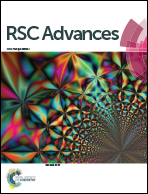Polyaniline nanorods random assembly on sugarcane bagasse pith-based carbon sheets with promising capacitive performance†
Abstract
Polyaniline (PANI) nanorods were randomly deposited on oxidized 2D sugarcane pith-based porous carbon nanosheets by using dilute polymerization methods. The random stacked morphology of the PANI nanorods on the oxidized pith-based porous carbon nanosheets (SPCN) can be effectively controlled by simply changing the molar mass of aniline monomer. When the molar mass of the aniline monomer is increased to 0.02 M, the PANI nanorods can be randomly and uniformly stacked on the oxidized SPCN. Most of these stacked pores derived from random stack of the PANI nanorods on the oxidized SPCN are mesopore and macropore. These stacked pores not only facilitate the diffusion of ions in the stacked layer of the PANI nanorods, but also mitigate mechanical deformation of the PANI nanorods during the doping/dedoping process. Furthermore, the relationship between the properties of the oxidized SPCN/PANI-X (X represents the molar mass of aniline monomer) electrode materials and molar mass of aniline monomer is explored in detail. The oxidized SPCN/PANI-0.02 exhibits the best electrochemical performance in 1 M H2SO4. The largest specific electrode capacitance is up to 513 F g−1 at a current density of 0.25 A g−1. The oxidized SPCN/PANI-0.02 also exhibits excellent electrochemical cycling stability.



 Please wait while we load your content...
Please wait while we load your content...